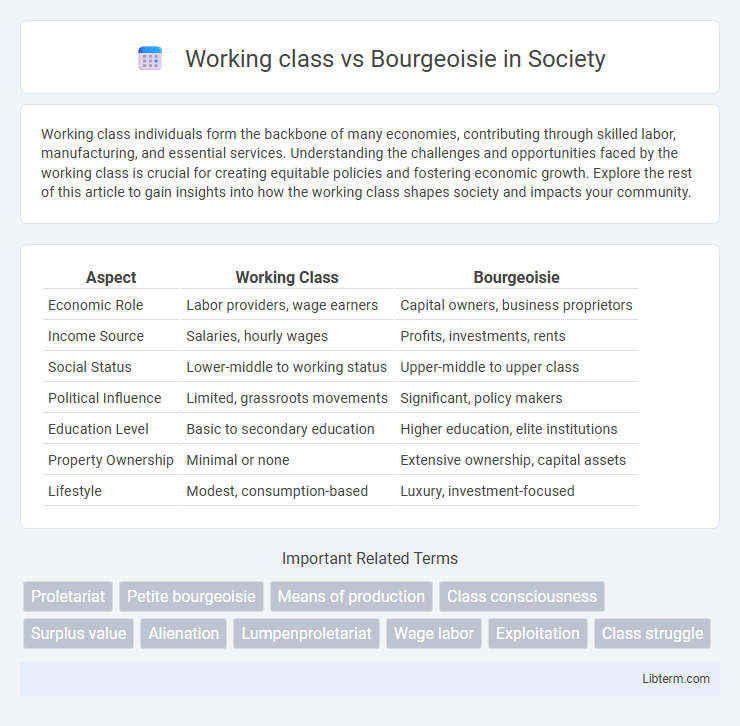Working class individuals form the backbone of many economies, contributing through skilled labor, manufacturing, and essential services. Understanding the challenges and opportunities faced by the working class is crucial for creating equitable policies and fostering economic growth. Explore the rest of this article to gain insights into how the working class shapes society and impacts your community.
Table of Comparison
| Aspect | Working Class | Bourgeoisie |
|---|---|---|
| Economic Role | Labor providers, wage earners | Capital owners, business proprietors |
| Income Source | Salaries, hourly wages | Profits, investments, rents |
| Social Status | Lower-middle to working status | Upper-middle to upper class |
| Political Influence | Limited, grassroots movements | Significant, policy makers |
| Education Level | Basic to secondary education | Higher education, elite institutions |
| Property Ownership | Minimal or none | Extensive ownership, capital assets |
| Lifestyle | Modest, consumption-based | Luxury, investment-focused |
Defining the Working Class and Bourgeoisie
The working class consists of individuals engaged in manual labor or industrial work, often earning wages through selling their labor power, with limited ownership of production means. The bourgeoisie represents the capitalist class owning factories, businesses, and capital, controlling production and benefiting from surplus value generated by the working class. Karl Marx's theory highlights the inherent class conflict arising from this economic relationship between the proletariat and bourgeoisie.
Historical Origins of Class Distinction
The historical origins of class distinction between the working class and bourgeoisie trace back to the rise of capitalism during the Industrial Revolution, where the bourgeoisie, as owners of the means of production, accumulated wealth and power. The working class emerged as wage laborers who sold their labor in factory settings, leading to a clear economic and social divide. This class structure was solidified through changes in property rights, industrialization, and urbanization in 18th and 19th-century Europe.
Economic Power: Ownership vs. Labor
The bourgeoisie wields economic power through ownership of the means of production, controlling capital, factories, and resources that generate wealth. In contrast, the working class contributes labor, exchanging work for wages but lacking ownership and decision-making authority. This dynamic creates an economic hierarchy where capital owners accumulate profits while workers face wage dependency and limited economic influence.
Social Mobility Between Classes
Social mobility between the working class and bourgeoisie often remains limited due to structural barriers such as unequal access to quality education, economic capital, and social networks. The bourgeoisie typically maintains advantages through inherited wealth and institutional influence, reinforcing class stratification. While some individuals from the working class achieve upward mobility through entrepreneurship or higher education, systemic inequalities frequently restrict widespread class transitions.
Class Ideology and Worldview
The working class typically embraces a class ideology centered on collective struggle, valuing solidarity, workers' rights, and equitable distribution of resources as central to their worldview. In contrast, the bourgeoisie upholds an ideology that emphasizes individualism, private property, and the preservation of capitalist frameworks to maintain social and economic dominance. These divergent worldviews shape distinct perceptions of social roles, power dynamics, and economic justice within capitalist societies.
The Role of Education in Class Structure
Education functions as a critical mechanism in reinforcing class structure by providing the bourgeoisie access to cultural capital and elite networks that sustain economic advantages. Working-class individuals often face systemic barriers in education, leading to limited social mobility and perpetuating income inequality. The disparity in educational resources and opportunities solidifies the division between the bourgeoisie and working class within capitalist societies.
Political Influence: Working Class vs. Bourgeoisie
The bourgeoisie wields significant political influence through ownership of capital, control of media, and lobbying, shaping policies that often prioritize corporate interests and economic growth. The working class exerts political power mainly through collective action such as unions, strikes, and voting, advocating for labor rights, fair wages, and social welfare reforms. Political systems tend to reflect the dominance of bourgeois values, yet sustained working-class mobilization can challenge and influence legislative agendas toward greater economic equality.
Cultural Representation and Stereotypes
The working class is often culturally represented as hardworking, humble, and community-oriented, frequently depicted in media through blue-collar jobs and relatable struggles. In contrast, the bourgeoisie is stereotyped as affluent, privileged, and detached from everyday challenges, symbolized by luxury and influence in cultural narratives. These contrasting representations reinforce social divides and perpetuate class-based stereotypes in literature, film, and popular discourse.
Modern Challenges Facing Each Class
The working class faces job insecurity due to automation and the gig economy, leading to unstable incomes and limited access to benefits. The bourgeoisie encounters challenges such as market volatility and increasing regulatory scrutiny, which threaten profit margins and global investments. Both classes must navigate the growing wealth gap and the socio-economic tensions it generates in modern capitalist societies.
Bridging the Divide: Toward Greater Class Equity
Bridging the divide between the working class and bourgeoisie requires implementing equitable wage policies and promoting worker ownership models to reduce income disparity. Strengthening labor unions and encouraging corporate social responsibility foster inclusive economic growth that benefits all social classes. Investing in education and skill development creates upward mobility, ensuring a more balanced distribution of wealth and opportunity.
Working class Infographic

 libterm.com
libterm.com